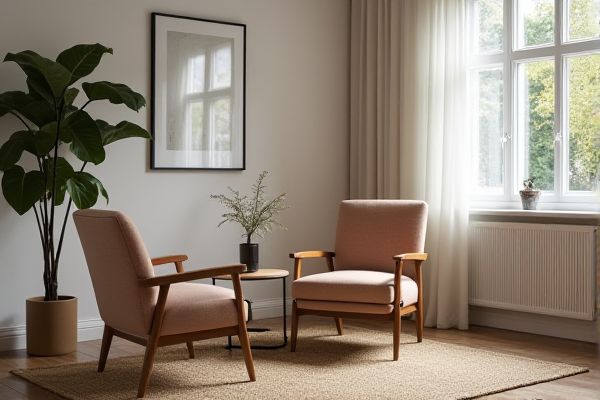
Dining chairs are designed primarily for comfort and functionality during meals, often featuring streamlined designs that complement kitchen or dining room tables, while accent chairs focus on style and comfort to enhance a room's aesthetic and provide additional seating. Discover how choosing the right chair can elevate Your living space by exploring the detailed differences in the article ahead.
Table of Comparison
| Feature | Dining Chair | Accent Chair |
|---|---|---|
| Purpose | Seating at dining table during meals | Enhances room decor and provides extra seating |
| Design | Simple, uniform, and functional | Stylish, varied, often bold or decorative |
| Comfort | Moderate comfort for short use | Higher comfort for extended seating |
| Size | Compact, standard height (18-20 inches seat) | Larger, varied dimensions |
| Materials | Wood, metal, plastic, sometimes with cushions | Fabric, leather, wood, metal with plush padding |
| Mobility | Lightweight, easy to move around table | Heavier, usually stationary |
| Usage Frequency | Daily use during meals | Occasional or decorative use |
Dining Chair vs Accent Chair: Key Differences
Dining chairs are designed primarily for use at the dining table, offering ergonomic support and durability for extended seating during meals, often featuring materials and styles that complement dining room decor. Accent chairs serve as decorative seating options, adding visual interest and personality to living spaces, with diverse designs that prioritize aesthetics over sustained comfort. Understanding these distinctions helps you select the right chair to enhance either functional dining experiences or stylish room accents.
Purpose and Functionality of Dining Chairs
Dining chairs are specifically designed to provide comfortable and ergonomic seating during meals, with features such as appropriate height, supportive backrests, and sturdy construction to accommodate prolonged sitting at a dining table. Their primary function is to complement dining tables while promoting good posture and ease of movement during eating. Unlike accent chairs, dining chairs prioritize durability and practicality to withstand frequent use in a dining environment.
Purpose and Functionality of Accent Chairs
Accent chairs serve as versatile furniture pieces designed to enhance the aesthetic appeal and provide additional seating in living spaces, distinguishing them from dining chairs primarily intended for mealtime use. They often feature unique designs, vibrant colors, and varied materials to complement interior decor while offering comfort for casual seating in lounges, bedrooms, or reading nooks. Unlike dining chairs, accent chairs emphasize style and visual interest without the uniform functionality or arrangement required around dining tables.
Design and Aesthetics Comparison
Dining chairs prioritize ergonomic design and simplicity to complement dining tables, often featuring streamlined shapes and materials like wood or metal for a cohesive meal setting. Accent chairs emphasize bold aesthetics with unique patterns, vibrant colors, and varied textures, serving as statement pieces that enhance your room's visual appeal. Your choice hinges on whether functional uniformity or standout style best suits your living space.
Comfort and Ergonomics: What to Consider
Dining chairs are designed with ergonomics that support upright posture during meals, featuring firm seating and backrests that promote comfort over shorter periods. Accent chairs prioritize aesthetic appeal and may offer plush cushioning and varied back angles suited for relaxation but might lack the structured support ideal for dining. When choosing, consider your primary use: Your dining area benefits from chairs that balance comfort with upright support, while accent chairs excel in adding style and comfort for lounging.
Material Choices: Dining vs Accent Chairs
Dining chairs are typically crafted from durable materials like hardwood, metal, or molded plastic to withstand frequent use and dining room conditions. Accent chairs prioritize aesthetic appeal and comfort, often featuring upholstered fabrics, leather, or velvet with decorative finishes to complement living room decor. Choosing between the two depends on balancing material durability for dining chairs versus the stylistic and textural variety offered by accent chairs.
Space and Placement Considerations
Dining chairs are designed for compact placement around a table, maximizing seating efficiency in dining areas where space is limited. Accent chairs offer greater flexibility, suitable for corners or open spaces to enhance decor without the constraints of table alignment. Choosing between the two depends on spatial layout and whether the primary goal is functionality or aesthetic enhancement.
Versatility and Usage Scenarios
Dining chairs are specifically designed for use around dining tables, offering comfort and support during meals, while accent chairs provide versatile seating options that enhance living rooms, bedrooms, or offices with style and functionality. Your choice depends on the space and purpose--dining chairs optimize mealtime comfort and cohesion, whereas accent chairs serve as flexible pieces for extra seating or decorative focal points. Both types can complement interior design, but accent chairs excel in adaptability across various rooms and activities.
Cost and Budget Factors
Dining chairs typically cost less than accent chairs due to simpler designs and materials focused on functionality rather than style. Accent chairs often feature more elaborate upholstery and unique designs, increasing their price and making them a larger investment for your budget. Choosing between the two depends on whether affordability or aesthetic impact is your priority.
Choosing the Right Chair for Your Space
Dining chairs are specifically designed for comfort and support during meals, featuring practical elements like upright backs and cushioned seats ideal for dining tables. Accent chairs serve as stylish focal points that complement a room's decor while providing extra seating, often emphasizing design and visual appeal over prolonged comfort. Selecting the right chair depends on the intended use: prioritize ergonomic dining chairs for functional seating around the table, and choose accent chairs to enhance the aesthetic and offer occasional seating in living or lounge areas.
 homyna.com
homyna.com